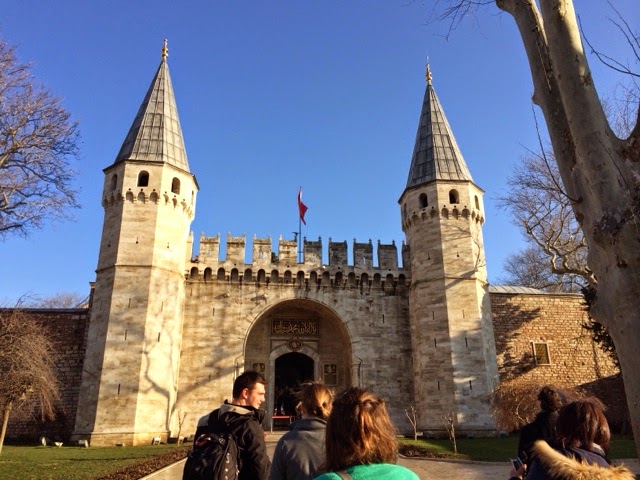This morning was the same as the other mornings with an 8:45am departure time, but compared to the other two days, we were greeted by the warm embrace of the sun we had not seen between the snow and the rain the other days. Because of the clarity, the view of the sea from the breakfast room was spectacular. For the first part of our group to arrive at breakfast we were lucky enough to see a submarine rise from the depths of the Sea of Marmara and head inland.
After breakfast we met up with Saba and walked a short way to the first gates of the Topkapi Palace, built by Mehmet II. While the palace itself is not known for it's size in comparison to the Hagia Sophia, it is known for its numerous buildings spread out over it's extensive grounds. The Ottoman sultans ruled their empire from the palace for over 400 years. This grounds included a mint, a hospital, and an armory, and several palace buildings all if which enabled about 4,000 people to live within it's walls. As a museum, the once exclusive walls of the inner gate have been opened to the public and just recently, the kitchen was put on display. As we walked through the gardens towards the picturesque inner gates of the palace, tulip bulbs were being planted and the Bosphorus sea was visible.
(Second gates)
There are four main buildings within the Topkapi Palace in which we spent the majority of our time.
The treasury, which consisted of four rooms housed the splendor of the Sultans and reflected their display of wealth as a way to express their power and authority. Some of the most well known pieces are the Topkapi dagger, and the 86-carat Spoonmaker's diamond. The diamond was said to be discovered by a merchant who traded it for a grand total of three silver spoons.
The next building we ventured into housed the relics. For the Ottoman Empire, these relics hold value through the strong connection between the object and the divine. The importance placed on divinity was another way in which the Sultans maintained power as a theopolitical empire (state and religion as a combined authority). The recently opened kitchen was incredible to see with the rooms displaying large pots and ladels a meter long in order to satisfy the hungry stomachs of 4,000 citizens. The final building and one of the most important was the Harem. The word itself is derived from the Arabic word meaning "forbidden". This is where the sultan's wives, concubines, children, and the sultan himself lived. Roxolana was one of the most famous concubines. Known for her ability to be manipulative and cunning she became the sultan's favorite concubine and shortly thereafter was given the title of Sultana. While she was disliked by the people for becoming too powerful, she was the sultans greatest confidant. From the tower of justice, located within the harem, the sultan was able to look over his city, which he may never have been able to enter as an heir born and raised inside the walls of the palace.
While the tower of justice provided a vantage point, the palace itself was strategically placed in order to maintain high ground to enforce authority over the city while bordering three different bodies of water. The Topkapi palace allowed the sultan to oversee the ongoings on the Sea of Marmara, the Bosphorus Sea, and the Golden Horn while now providing a perfect background for selfies.
(View from Topkapi palace)
From the inner core of the palace, we made our way to the Archeological Museums filled with floors of artifacts varying from classical statues to carved sarcophagi and ranging from the biblical Old Testament times to the Byzantine Empire. One activity we did was to pair up and go through the artifacts, finding one that we could analyze and conclude why it was important to keep for the Ottoman Empire. The Ancient Orient Museum, located beside the archeological museum contained a few interesting artifacts including a copy of the Code of Hammurabi, parts of the gates if Ishtar, and an Egyptian sarcophagus. From there the students broke off to get lunch and explore the city on their own for the rest of the day.
~Emily Bell



No comments:
Post a Comment